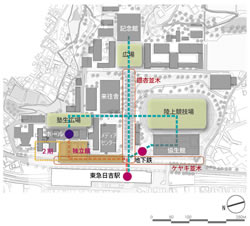Last Uploaded: April, 2011
Keio University Hiyoshi Campus Fourth Building, Independence Wing
Special Features
| Q-1 Indoor Environment |
- Noise criteria (NC) level of 25-30
- Classroom sash sound insulationperformance of class T-2
- Large lecture theater wall sound insulation performance of TLD-56 (D-45)
- Classroom floor sound insulation performance of L-55
- Majority of classrooms achieve a daylight factor of 3.0 or higher
- Installation of effective skylights as a means of increasing daylight usage
- Daylight control through the use of eaves and blinds
- Achieves lighting intensity of 750 lux or higher
- Used construction materials with low VOC discharge
- External air inlet volume 25m3 / person / hour
- No smoking allowed inside the building
|
| Q-2 Quality of Service |
- Complies with the Heart Building Law
- Classroom ceiling height of 3.2m-3.95m
- A space with a diverse array of features that encourages communication
- Aseismic performance that exceeds the legally mandated level by 50%
- Utilizes seismic isolation system
- Architectural precast concrete panels faced with porcelain tiles
- 30-year interval between renewals
- Air conditioning systems in high-priority rooms have autonomous ducting to external units
- A facilities plan that follows the seismic isolation system
- Measures undertaken to reduce risk of electrical room flooding
- Each floor has a height of 4.0m or over
- Rack ES full-surface inspection flaps and underfloor cable routing for office automation (OA) equipment
- Telecommunication cable routing may be reconfigured without causing damage to structural members or finishing materials
|
| Q-3 Outdoor Environment on Site |
- Understanding of the site's vegetation and biological environment
- Creation of cherry blossom and zelkova tree-lined avenues and other continuous green spaces to enhance amenity value for strolling
- Reuse of site's existing topsoil
- Provision of habitat for birds
- Over 60% of external area made into green space
- Building green space rating of 0.06
- Provision of green roadside space for the enjoyment of pedestrians
- Provision of intermediary spaces linking building interior with the outside (approach avenue, etc.)
- Plan to enhance line of sight by demolishing an existing concrete retaining wall
- Indoor-outdoor connecting space provides a pathway for the wind
- Provision of shade from the sun and green areas and the use of water-retentive pavement material contribute to improvement in the site's thermal environment
|
| LR-1 Energy |
- Use of low-E glass; PAL value of 272.3
- Atrium skylight facilitates natural lighting / air flow / ventilation system
- Reduction of outdoor air thermal load through the use of total heat exchanger
- Cool tube utilizing seismic isolation level
- Adoption of an air conditioning operational-data management system that is able to conduct a range of measurements of energy conservation performance
|
| LR-2 Resources and Materials |
- Measures to conserve water, including automatic faucets, water-saving faucets and user sensor systems
- Use of rainwater to supply water for toilets and urinals
- Use of electric furnace steel in main structure; use of Portland blast furnace cement in some parts of main structure
- Use of recycled lumber in roof garden floor deck
- Use of construction materials that do not contain hazardous substances
- Reuse of concrete structure of previous building in exterior design
- Non-use of halon fire extinguishing agents
- Use of insulation materials which have ratings of ODP=0 and GWP=0
|
| LR-3 Off-site Environment |
- Measures to prevent light pollution
- No advertising signs
- Wind environment simulations used to reduce impact on surrounding environs
- Waste disposal burden reduced through such measures as separation of waste and separate collections for each category; paper recycling; reduction of bottle and can volumes
|
Other Features
These cases are described based on assessment results obtained using
CASBEE.
CASBEE is a method for rating the environmental performance of buildings using
Building Environmental Efficiency (BEE) as an indicator, which is based on the results of
separate scores obtained for Q-1~Q-3 (Quality) and LR-1~LR-3 (Load Reduction).















 Next Building
Next Building















 | Copyright © 2008 Institute for Building Environment and Energy Conservation, All Rights Reserved.
| Copyright © 2008 Institute for Building Environment and Energy Conservation, All Rights Reserved.